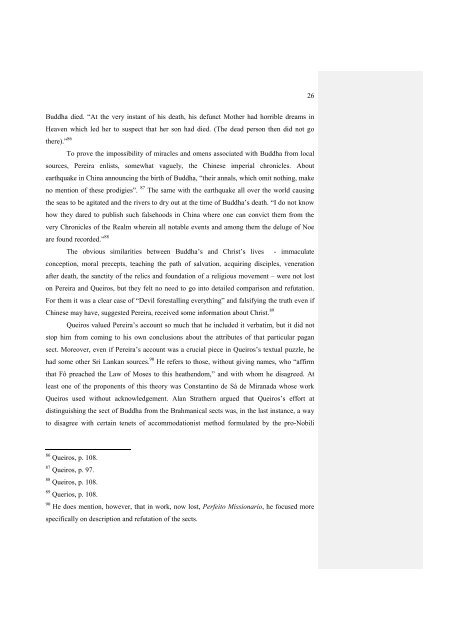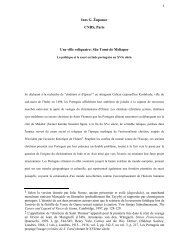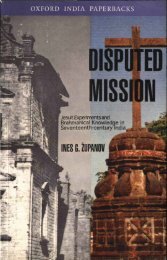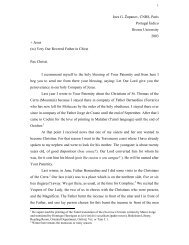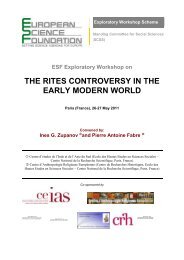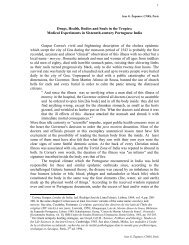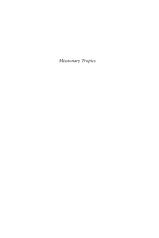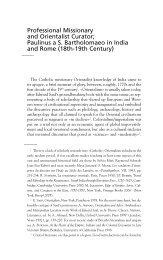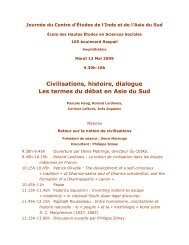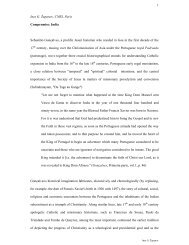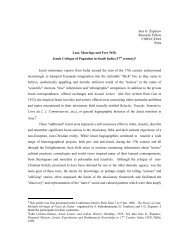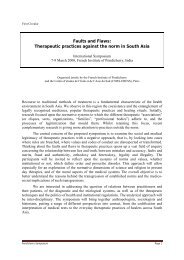Jesuit Orientalism; - Ines G. Županov
Jesuit Orientalism; - Ines G. Županov
Jesuit Orientalism; - Ines G. Županov
Create successful ePaper yourself
Turn your PDF publications into a flip-book with our unique Google optimized e-Paper software.
26<br />
Buddha died. “At the very instant of his death, his defunct Mother had horrible dreams in<br />
Heaven which led her to suspect that her son had died. (The dead person then did not go<br />
there).” 86<br />
To prove the impossibility of miracles and omens associated with Buddha from local<br />
sources, Pereira enlists, somewhat vaguely, the Chinese imperial chronicles. About<br />
earthquake in China announcing the birth of Buddha, “their annals, which omit nothing, make<br />
no mention of these prodigies”. 87 The same with the earthquake all over the world causing<br />
the seas to be agitated and the rivers to dry out at the time of Buddha‟s death. “I do not know<br />
how they dared to publish such falsehoods in China where one can convict them from the<br />
very Chronicles of the Realm wherein all notable events and among them the deluge of Noe<br />
are found recorded.” 88<br />
The obvious similarities between Buddha‟s and Christ‟s lives - immaculate<br />
conception, moral precepts, teaching the path of salvation, acquiring disciples, veneration<br />
after death, the sanctity of the relics and foundation of a religious movement – were not lost<br />
on Pereira and Queiros, but they felt no need to go into detailed comparison and refutation.<br />
For them it was a clear case of “Devil forestalling everything” and falsifying the truth even if<br />
Chinese may have, suggested Pereira, received some information about Christ. 89<br />
Queiros valued Pereira‟s account so much that he included it verbatim, but it did not<br />
stop him from coming to his own conclusions about the attributes of that particular pagan<br />
sect. Moreover, even if Pereira‟s account was a crucial piece in Queiros‟s textual puzzle, he<br />
had some other Sri Lankan sources. 90 He refers to those, without giving names, who “affirm<br />
that Fô preached the Law of Moses to this heathendom,” and with whom he disagreed. At<br />
least one of the proponents of this theory was Constantino de Sá de Miranada whose work<br />
Queiros used without acknowledgement. Alan Strathern argued that Queiros‟s effort at<br />
distinguishing the sect of Buddha from the Brahmanical sects was, in the last instance, a way<br />
to disagree with certain tenets of accommodationist method formulated by the pro-Nobili<br />
86 Queiros, p. 108.<br />
87 Queiros, p. 97.<br />
88 Queiros, p. 108.<br />
89 Querios, p. 108.<br />
90 He does mention, however, that in work, now lost, Perfeito Missionario, he focused more<br />
specifically on description and refutation of the sects.


